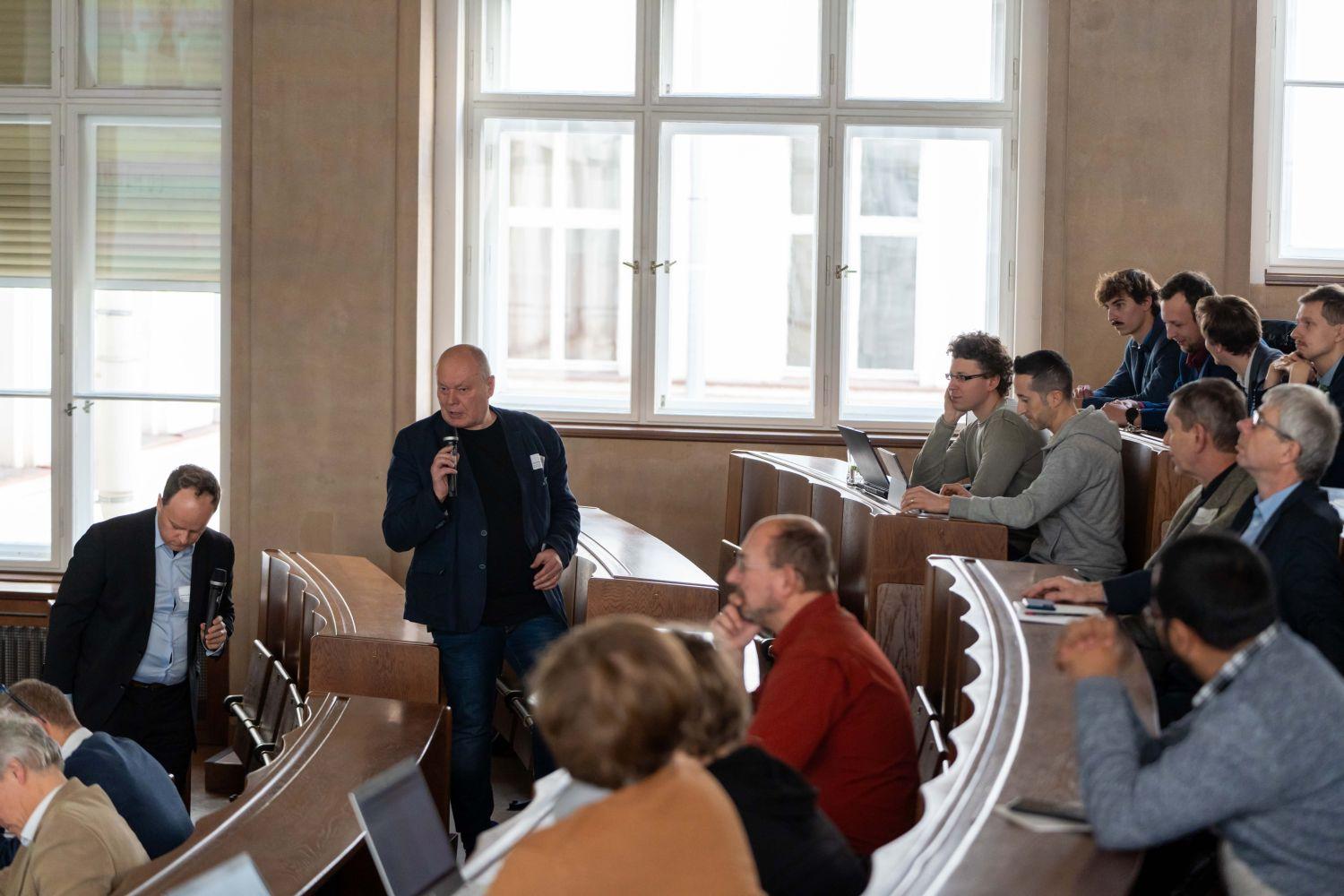
ECO&Stor: Leading research groups join forces to address the energy challenges of the future
The ECO&Stor project aims to coordinate research activities in the broadly defined field of energy conversion and storage. This aim is achieved by connecting leading research groups and research areas in the Czech Republic (from traditional batteries, over the conversion of energy into chemical bonds, to the use of solar energy). In such a way, a higher level of results and outreach will be achieved. It considers the issue of energy conversion in its entire broadness and richness. The scope covers the entire way from theoretical understanding, over the experimental validation of the phenomena and related engineering to the real implementation in the energy distribution system. Project consortium represents a very complex alliance benefiting significantly from the extensive international collaboration networks of its members, reaching far beyond formal agreements and official declarations. Details about the first ECO&Stor conference and the project itself are revealed in this interview with ECO&Stor leading figure and Scientific project manager, UCT Prague’s Professor Karel Bouzek.
UCT Prague hosted the first ever ECO&Stor conference. Did it meet your expectations, and how would you evaluate the conference in terms of organization?
Since it was the first conference edition, we did not have a clear idea of what to expect. I must say, I personally was very pleasantly surprised, from two perspectives. At first, from my perspective as a professional guarantor. The conference was the first opportunity to meet the majority of the approximately 200 members of the project’s research team. I was worried only a small number of them will join. Thus, they will not be aware of the importance of their role in the project, which is interconnected and complex. To minimise this risk, a significant part of the conference program was reserved for introducing the project itself. So, the individual teams and their members could realize they are a part of one big machine. This way, they can understand how their work is interconnected to other parts of the project and the way they shall support each other. At second, from the perspective of a conference participant, I can say, I appreciated the very good work done by the organizational team. It is reflected also in the fact that most of the participants stayed until the end of the conference.
How many participants did register?
The conference had approximately 120 registered participants. This included additional visitors such as members of the International Advisory Board, representatives of partner institutions, and so on. There were 14 speakers.
Do you have any feedback from participants yet?
The direct feedback we received from participants on site was very positive. Not only the conference, but also the entire project was positively evaluated by members of the International Advisory Board as well. Of all the aspects of the project, its interdisciplinary nature and complexity are the most striking and the most challenging ones. Representatives of the Ministry of Education, Youth and Sports, which funds the project, also joined us for the first part of the program. They had a unique opportunity to get acquainted with the working form of the project and at the same time to connect reports and materials delivered with concrete faces.
Would you like to highlight some of the most interesting moments from the conference?
The fact that everything worked out in the end and that the team members as well as the International Advisory Board gathered in such large numbers. I was surprised by the enriching panel discussion at the end of the programme. It often seems that the moderator has to laboriously initiate discussion. In this case, however, the audience asked numerous interesting questions. I hope and firmly believe that the discussion served to improve mutual understanding between team members and project management.
What would you do differently next time?
Looking back, I don’t think we would approach this first conference any differently if we had to repeat it. The first year is over. In the second year, we will no longer need to present in detail the project as such. This will free up more space for presenting results achieved. At the same time, we would like to give early career researchers the opportunity to present their work.
ECO&Stor focuses on energy storage. What is the biggest challenge in this area right now?
Energy is the driving force of our entire human civilization. Since the invention of the steam engine, the increase in energy consumption has been exponential. And energy demands will probably not stop growing. But now we are really starting to perceive the fact that our resources are not unlimited. This is accompanied by the awareness of the need to diversify sources of energy in the future. For example, natural gas reserves and even oil will not be exhausted in the near future, but the costs associated with their extraction will continue to increase. Moreover, oil is also a basic raw material for the chemical industry. Currently, however, we burn the largest share of it. Another role is played by the political situation and international relations. We are increasingly aware of the need to ensure the stable development of society, independent of unstable or antagonistic political systems.
So diversify and diversify. Which technologies seem to be the most promising?
It will depend a lot on specific applications. In the case of short-term energy storage associated with the flows of high current, you will choose capacitors. In them, you will retain a large amount of energy in a burst, but these bursts can be stored for no longer than tens of hours. For less intense flows, and storage for up to weeks, batteries are suitable. For longer-term energy storage without losses, storage in the form of chemical bonds is more suitable. And given the fact that Europe will never be fully self-sufficient in energy, this approach (chemical bond energy) also represents a suitable alternative to natural gas and oil for transporting large volumes of energy over long distances.
When do you think we will see the results of the project in real life? What are the specific steps needed to implement these technologies?
According to the call for proposals within the framework of which this project is funded, our main focus is on basic research. Therefore, specific applications are generally not in the scope. However, the experience, knowledge, and data gained from basic research performed will be an excellent basis for spin-off projects. The mission of the project is not to develop a single specific technology, but to find a comprehensive solution to the energy situation. Nevertheless, I expect that the first results will find practical implementation before the end of the project. However, this will happen within the framework of follow-up projects or newly established collaborations.
What role does UCT Prague play in the project? What specific research is being conducted here?
UCT Prague has two important roles. The first one represents a coordinating role: we ensure the administrative management of the partners, and we are to some extent responsible for the quality of our partners' work outputs. This is the only project of its kind UCT Prague coordinates. The second role is related to our scientific expertise. UCT Prague is involved in five of the six research directions and leads three of these research streams.
The project consists of the following six research directions:
• Batteries and supercapacitors
• Power-To-X (storing electrical energy into an energy in chemical bond and its recuperation)
• Solar-To-X (storing solar energy into an energy in chemical bond)
• Molecular design in energy storage and conversion
• Engineering of storage and conversion systems
The only research direction in which UCT Prague is not directly involved is:
• Energy: buildings, cities, and communities
What fascinates you most about this project?
What also scares me the most: its complexity. The structure ranges from theoretical calculations at the molecular level to the integration into urban areas. This creates quite high demands on the methods of internal communication. The team members speak many different languages. Here I don’t mean English and Czech. What I mean is a largely diversified professional terminology and the variety of the methods of communication. Then there is the scope of the project. There are 200 creative, enterprising, and independent academics. Of course, they don’t usually consider it important to read rules and manuals. So it is fascinating that after the first year of the project, the individual groups have learned to communicate with each other and understand the interconnectivity of their research activities.
It is not only about building valuable contact networks, but also about mutual enrichment from the point of view of research and science, about looking at their field of research from the perspective of another scientific field. That’s how top scientists are learning to assess their research from a different perspective and, as a result, are getting new impulses for their work.
Does the Czech Republic have the potential to become a leader in new energy storage technologies?
Absolutely! Czechia has strong mechanical engineering roots, cutting-edge electrical engineering, and a growing IT sector. Not mentioning electrical engineers. These areas form a solid foundation for innovation in the energy sector. The key to success is to perceive technological change and the transition to sustainable solutions as an opportunity for growth and competitiveness. If we effectively use our expertise, invest in research, and connect academia with industrial partners, we become a major player in the field of modern energy technologies.
If students wanted to participate in similar research, what would you recommend to them?
Many of UCT Prague’s departments are involved in this project. A number of doctoral candidates, as well as some graduate and undergraduate students, are engaged in it as part of their theses. There are many ways to get involved. Just look around, ask around, and you will definitely find an opportunity. If we are to compete in the global market, we need high-quality young scientists.
Would you like to add any other thoughts here?
This is a very ambitious and demanding project, but it is also a great opportunity. An opportunity to establish new contacts and to strengthen the role of UCT Prague in national and global research on the applications of chemical transformations in the field of energy. Let us become a centre where these threads converge and expand our field of activity further.
If you want to watch the conference recording, you can find it on our YouTube channel.







